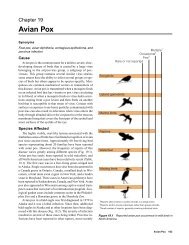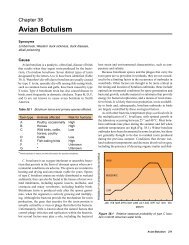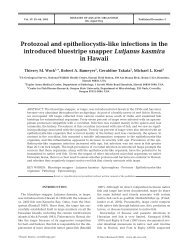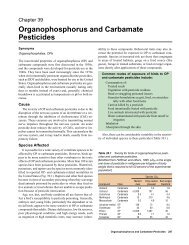Biowarfare, Bioterrorism, and Animal Diseases as Bioweapons
Biowarfare, Bioterrorism, and Animal Diseases as Bioweapons
Biowarfare, Bioterrorism, and Animal Diseases as Bioweapons
You also want an ePaper? Increase the reach of your titles
YUMPU automatically turns print PDFs into web optimized ePapers that Google loves.
Illustration by John M. Evans<br />
Secondary transmission<br />
• Aerosol movement of virus <strong>as</strong> small particles that<br />
remain suspended <strong>and</strong> spread over a wide area<br />
Contaminated<br />
fomite movement<br />
to other locations<br />
Close contact transmission<br />
• Droplets expelled from mouth/nose of<br />
infected person infect other people within<br />
6-8 feet <strong>and</strong> contaminate area<br />
• Contaminated fingers <strong>and</strong><br />
objects provide another route<br />
for infection of those in close<br />
contact with infected individuals<br />
Fomites<br />
Figure 6.3 Smallpox, a person-to-person <strong>and</strong> person-to-fomite-to-person dise<strong>as</strong>e (developed from Fenner et al. 30 ).<br />
Present <strong>Biowarfare</strong> <strong>and</strong> <strong>Bioterrorism</strong><br />
“In my opinion biological agents, along with death rays,<br />
sonic beams, neutron bombs <strong>and</strong> so on, belong more to<br />
the realms of science fiction than to practical warfare. But<br />
my opinion is not widely shared <strong>and</strong> the fount [supply] of<br />
human imbecility seems inexhaustible,…” 35<br />
The incre<strong>as</strong>ed threat to society from bioterrorism that<br />
ushered in the 21 st century within the USA w<strong>as</strong> a growing<br />
concern during the 1990s. 36–40 That concern w<strong>as</strong> b<strong>as</strong>ed on<br />
incre<strong>as</strong>es in terrorist incidents taking place globally, disclosures<br />
of major covert bioweapon development in the former<br />
Soviet Union <strong>and</strong> Iraq, <strong>and</strong> evaluations that indicated a shift<br />
in terrorist motivations. Primary motivations from 1975 to<br />
1989 were protests against government policies. Since 1990,<br />
the primary motivations include retaliation or revenge <strong>and</strong> the<br />
pursuit of nationalist or separatist objectives. 28,40<br />
Concerns about incre<strong>as</strong>ed risks from terrorism were<br />
expressed in prophetic statements such <strong>as</strong>, “Many experts<br />
agree that it’s just a matter of time until the United States or<br />
another country suffers a significant bioterrorist attack.” 36,41<br />
Primary concerns raised at that time focused on the inadequacy<br />
of USA preparedness <strong>and</strong> infr<strong>as</strong>tructure to respond<br />
to an attack in which infectious dise<strong>as</strong>e agents were the<br />
weapons. 1,42 Indeed, from October 30 through December 23,<br />
1998, the Centers for Dise<strong>as</strong>e Control <strong>and</strong> Prevention (CDC)<br />
received reports of a series of threats involving anthrax-laced<br />
letters being sent though the mail. All were investigated <strong>and</strong><br />
found to be hoaxes. Nevertheless, the CDC issued interim<br />
guidance for response to such threats becoming reality. 43<br />
Those hoaxes followed the highly publicized arrest of a<br />
236 Dise<strong>as</strong>e Emergence <strong>and</strong> Resurgence: The Wildlife–Human Connection<br />
microbiologist linked to a white-supremacist group who had<br />
threatened to use military-grade anthrax in attacks against<br />
the government. 40<br />
In 2001, the Johns Hopkins Center for Civil Biodefense<br />
Strategies further raised attention to the dangers of microbial<br />
terrorism by staging a mock smallpox attack within the USA<br />
called “Dark Winter,” which illustrated a major need for better<br />
preparation 44 <strong>as</strong> did TOPOFF, a mock plague outbreak held<br />
in 2000. 27 Concerns in the USA about terrorism <strong>and</strong> the level<br />
of preparedness became reality with the infamous events<br />
of September 11, 2001, <strong>and</strong> the subsequent anthrax attacks<br />
through the U.S. mail system. 45,46<br />
The anthrax letter attacks of 2001 generated great terror<br />
among the public, 27,47–49 reemph<strong>as</strong>ized that the USA<br />
population is not immune from terrorist attacks with biologic<br />
agents, 50 <strong>and</strong>, despite the previous anthrax threats <strong>and</strong> letter<br />
hoaxes, 40,43 emph<strong>as</strong>ized that the greatest threats from bioterrorism<br />
will likely involve something never before seen <strong>as</strong> an<br />
application. 51 Although the potential for biowarfare remains<br />
a concern <strong>and</strong> disarmament efforts by the international<br />
community continue, 52–54 the threat of bioterrorism is now<br />
of greater concern in the USA <strong>and</strong> in many other nations 55,56<br />
(Box 6–1).<br />
<strong>Biowarfare</strong> versus <strong>Bioterrorism</strong><br />
Biological weapons are considered to be weapons of m<strong>as</strong>s<br />
destruction or, more appropriately, weapons of m<strong>as</strong>s c<strong>as</strong>ualty.<br />
“Because they are invisible, silent, odorless, <strong>and</strong> t<strong>as</strong>teless,<br />
biological agents may be used <strong>as</strong> an ultimate weapon—e<strong>as</strong>y<br />
to disperse <strong>and</strong> inexpensive to produce.” 67 The international

















